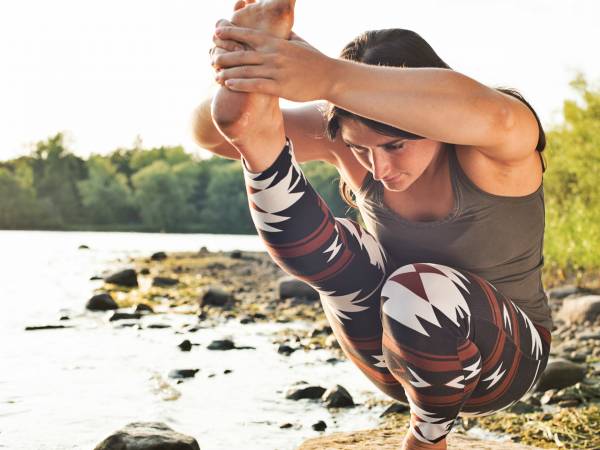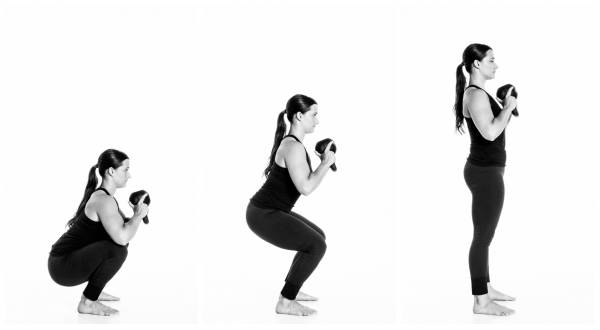You consider yourself a yogi. You go to class regularly, and can contort yourself into a variety of shapes. You even attend the occasional weekend workshop to deepen your practice and explore more advanced moves, like handstand.
As a yoga student, you feel strong and flexible, but sometimes you feel a little twinge; a subtle hint that perhaps things aren’t quite as strong as they could be. You notice it when your partner asks you to help lift furniture. You can balance your bodyweight on your hands. Lifting a couch can’t be too different, right? Except it is, and you hear a nagging voice in the back of your head suggesting something is missing from your practice; something that might improve how capable you feel outside of the studio.
How does a regular yoga practitioner introduce resistance training into her (or his) practice? Can the two seemingly different methodologies reconcile their opposing viewpoints and find a place of balance, complimenting rather than opposing each other?
The Yoga Plateau
To answer this question, I sought the opinion of Kathryn Bruni-Young, a long-time yoga practitioner and teacher who has also studied the principles of strength and conditioning, and competed in powerlifting. She believes in the value of flexibility; she also believes in the power of picking up heavy things. She blends mindful movement, flexibility, and power in an interesting, yet comprehensive way.
“At least once or twice a week I try to lift weights, once or twice a week is a bodyweight day. Maybe once a week is just mobility; quiet stretching by myself,” she says of her regular routine. It is a balance that might benefit more yoga practitioners.
There is something about yoga when you stumble upon it for the first time that provides a sense of connected solitude. It’s you, your mat, your breath, and 20 other people moving mindfully, without your phone or any outside thoughts. You listen to the teacher’s instructions and move. It enables a sense of focused attention that is missing in other forms of exercise.
At first, yoga leads to an increase in strength and flexibility. Any time you introduce a novel stimulus to the body in the form of movement, there is a bit of a honeymoon period where the body adapts. The nervous system becomes more effective, and there is an increase in the amount of motor units that fire so the muscles can accomplish the specific task.1 This is also known as the SAID principle: specific adaptations to imposed demands.
However, once a person practices for months or years, the practice is no longer new. The sequence might be fresh, but the movements are inherently similar; repetitive in a way that leads to a plateau in strength and mobility. This doesn’t mean they can’t still lead to some improvement; it’s just that the improvements will happen more slowly. If you continue to approach the asana or posture in exactly the same way, things will become stagnant.
Stronger Muscles for a Stronger Practice
Diversifying movement through strength training, mobility, and bodyweight work creates a more resilient structure. As Kathryn points out, “I think the constantly varied approach is so important in yoga. There is this idea of you going and doing the same thing every single day, and it gets better over time. But I think that is a little bit flawed and a little bit misleading for intermediate students who are dedicating a lot of their time and effort to that approach. I think finding ways to build more strength and more functional mobility in the body is probably a lot more of an efficient way to get into these more advanced yoga poses, if that’s where you want to go.”
The question, of course, is how? How does one build strength that is complimentary to a practice where mobility is rewarded in the form of more advanced postures? Aren’t the goals and practices of strength and mobility at odds?
The sensation of muscle stiffness isn’t necessarily related to a muscle being short or not in a lengthened position. A person can feel tight, despite the fact he is just as flexible as the next-door neighbor, who doesn’t feel any sensation of tightness.2
For instance, take the yoga practitioner who can drop into the front splits cold, but still feels like her hips are tight. Are her hips actually, physically tight? Probably not. Her sympathetic nervous system might be in overdrive, causing her to be a in heightened state of fight or flight.3 Or she might actually be weak in her hips, and that’s what’s causing her to feel the sense of tightness—it’s like her nervous system is in overdrive.4

In both cases, adding in varied movement can be helpful, and strength training may very well eliminate the sensation of tightness.
“I used to deal with a lot of posterior chain weakness, lower back pain, very minor hamstring tears,” Kathryn says. “When I started resistance training and actually making those connective tissues and muscles stronger, all of those feelings went away, so then I didn’t have to worry about tearing my hamstring. So in that way, it made my yoga practice a lot stronger.”
The idea that strength training can result in a stronger yoga practice at first seems counterintuitive. Doesn’t strength training make your muscles stiffer, less supple? Not necessarily. In fact, a small, often cited study published in 2011 found resistance training was as effective as static stretching at increasing flexibility.5
However, there are certain postures that might be effected. “Maybe I’m not going to be able to put my foot behind my head anymore,” Kathryn admits, “which at this point is totally fine, but in the first couple of months it was sort of an existential crisis. You identify so much with the practice and certain poses, and the fact that you can’t do that anymore is a bit of a dilemma.”
How to Add Strength Training To Yoga
Which leads us to the final aspect of understanding how to combine resistance training and yoga. What are your goals? Is your goal to be a yoga superstar on Instagram? If so, use strength training to support the yoga practice. You will need to use the minimum dose to be effective, and its purpose will be to build the minimum amount of strength needed to feel stable and secure.
On the other hand, if your goal is to use yoga as a mindful, personal practice and you want to feel strong and flexible, resistance training could play a slightly bigger role. Instead of once a week, you incorporate weights twice a week. You may even figure out ways to use strength to get into postures you usually access passively by using your hands to move your legs.
How does a yoga practitioner implement strength training as an adjunct to the practice? Kathryn answers, “I would try to do some type of resistance training twice a week. For the upper body, I would work on one push, one pull. For the lower body, some type of goblet squat with really light weight and one type of deadlift pattern.”
Below is a sample progression of resistance training with yoga. The program below uses strength training as an adjunct to the yoga practice.
Program A:
Perform this routine for 4 weeks, before moving on to Program B. Weights are just suggestions. Adjust as needed, but make sure you remember it’s about quality versus quantity.
Monday
- Yoga
Tuesday
- Joint mobility
- Push-ups. Perform slowly, on your knees, at a level where you can maintain a sense of quality and ease throughout the movement. Rest for 1-2 minutes between sets. Perform 1-3 sets of 5-7 repetitions.
- Bar hang. Find a grip that feels adequate; if it is too challenging to hang from a bar, find a low bar and set yourself up so your feet are on the ground in front of you for support. Work up to hanging for 30 seconds. Rest for 1-2 minutes between rounds. Perform 1-3 sets of 10-30 seconds.
Wednesday
- Yoga
Thursday
- Yoga
Friday
- Joint mobility
- Deadlift, 10-15lb kettlebell. Control the movement on the way down. Make sure you have a solid grip on the kettlebell. If you have question on how to deadlift, please check out this article. Focus on a sense of quality and ease throughout the movement. Perform 1-3 sets of 8-10 repetitions. Increase weight as ease improves.
- Goblet squat, 10-15lb kettlebell. Use a bottoms-up grip. Control the movement on the way down, and focus on quality and ease. Perform 1-3 sets of 8-10 repetitions.

Program B:
Monday
- Yoga
Tuesday
- Joint Mobility
- Push-ups. Begin on your toes. Focus on lowering down slowly. Lower to your knees to push back-up. Perform 4-6 sets of 5-7 repetitions. Rest for 1-2 minutes between sets. Maintain quality and ease throughout the movement.
- Bar hang with scapular pull. Hang from the bar with palms either facing you or away from you. Keep your arms straight as you exhale and begin to pull the bar towards you. Your shoulders will move down (away from the bar). Inhale, relax to the starting position. Perform 1-3 sets of 4-6 repetitions.
Wednesday
- Yoga
Thursday
- Yoga
Friday
- Joint mobility
- Deadlift, 4-6 sets of 6-8 repetitions with a weight that you can control and maintain good quality movement. For instance, two kettlebells, 20-30lb each, might be a good place to start.
- Goblet squat, 15-25lb kettlebell, standard grip or bottoms-up grip, 4-6 sets, 5-7 repetitions. Rest 1-2 minutes between sets.
As you begin building a base of strength, you will notice the moves above become easier. That is the nature of movement; as body control, coordination, and strength improve, the movements become more effortless. When this happens, it’s time to either increase load or diversify the movements. As Kathryn says, “I think it’s a really important concept for people with yoga that it has be to be varied, it doesn’t have to be the same thing every day.”
Don’t be afraid to spend enough time on movements to gain competency, move away from things for a little while, and return. Cycling through exercises (and asanas) keeps things fresh and enables you to view movements and positions in a less mechanical way. Do your practice, but add strength to maintain balance.
References:
1. Hong, A-R., Hong, S-M., & Shin, Y-A., (2014). Effects of resistance training on muscle strength, endurance, and motor unit according to ciliary neurotrophic factor polymorphism in male college students. Journal of Sports Science Medicine, 13(3), 680-688.
2. Kuilart, K.E., Wollam, M., Barling, E., & Lucas, N., (2005). The active knee extension test and slump test in subjects with perceived hamstring tightness. International Journal of Osteopathic Medicine, 8, 89-97.
3. Hallman, D., (2013). Autonomic nervous system regulation in chronic neck-shoulder pain. Digital Comprehensive Summaries of Uppsala, Dissertations from the Faculty of Medicine, 851.
4. Garrick, J.G.; Webb, D.R. Sports Injuries: Diagnosis and Management. Philadelphia, W.B. Saunders 1990; pp 7-25.
5. Morton, S.K., Whitehead, J.R., Brinkert, R.H., & Caine, D.J., (2011). Resistance training vs. static stretching: effects on flexibility and strength. Journal of Strength and Conditioning Research, 25(12), 3391-3398.






